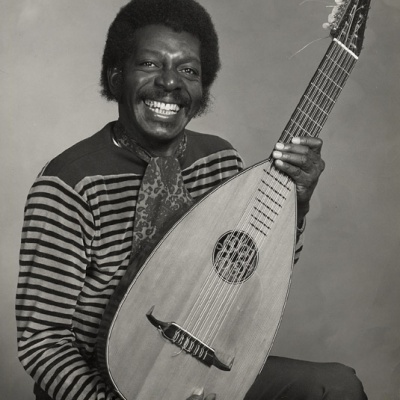
Bola Sete
by Alvaro NederThe words Bola Sete are Portuguese for the seventh ball in the billiard game, which is the only black one. He got his nickname after being the only black man in a small group. From an early age, he was habitual at the Bohemian circles of Praça Tiradentes, Rio, where musicians met. At 17, he joined composer Henricãos group, which was going to Marília for an eight-month season. Returning to Rio, he played at every available venue in Campinas SP and Niterói RJ. In 1945, Rios Rádio Transmissora instituted a violão (acoustic guitar) contest, in which he was the winner. He continued to play through Minas Gerais and Rio. At last, he was hired contractually by Rádio Transmissora and he worked in the famous Trem da Alegria show for three years at the João Caetano Theater with Lamartine Babo, Iara Sales, and Héber de Bôscoli. At the end of the 40s, he formed his own group, Bola Sete e seu Conjunto. In that time, Dolores Durán, who went on to be a famous singer and composer, was a crooner at the Béguin nightclub and once invited, became the groups singer at the Drink and Vogue nightclubs. In 1952, he went to Italy and played in several clubs and hotels until 1954. In that year, he returned to Brazil and formed an orchestra, with which he toured through Argentina, Uruguay, and Spain. In 1955, he toured again, this time through Lima, Peru, and Santiago do Chile. In 1959, he moved to the U.S. and in 1962, was hired directly by the general manager of Sheraton Hotels to play in the several units of that chain. In 1960, the label Sinter, which had already recorded several cuts with him, released the LP Bola Sete. He had also recorded for Odeon, which released at the same time Bola Sete e Quatro Trombones with his own compositions and Gershwin standards. In 1962, he appeared at the historic Bossa Nova Festival at Carnegie Hall in New York. He also played at the Village Gate and Vanguard. In the same year, Odeon Brasil released O Extraordinário Bola Sete and Fantasy released Bossa Nova. He was then playing at New Yorks Park Sheraton and later in the same year, he moved to San Francisco to play at the Sheraton Palace. Dizzy Gillespie was staying there and listened to him every night. When Gillespies pianist, Lalo Schifrin, came to the hotel, he met Sete, with whom he had become acquainted and played with when the Brazilian toured Argentina. Invited by Gillespie, Sete played with him at the Ninth Annual Monterey Jazz Festival with great success. Following tours and a recorded album with Gillespie, Sete moved again to San Francisco and joined Vince Guaraldis trio. This two-year association, profitable for both artists, consolidated the already expressive popularity of Sete in the U.S. They recorded together 1963s Vince Guaraldi, Bola Sete & Friends (Fantasy). Then he formed his own trio with Brazilian musicians Tião Neto (bass) and Chico Batera (drums), with which he performed at the 1966 Monterey Jazz Festival, again with great success. From November 11 to 13, 1966, Sete was featured at the Fillmore Auditorium. His releases in the U.S. include 1964s Tour de Force and From All Sides (with Vince Guaraldi), 1965s The Solo Guitar of Bola Sete and The Incomparable Bola Sete, 1966s Live at El Matador (with Vince Guaraldi) and Autentico, 1967s At the Monterey Jazz Festival, 1969s Shebaba (all through Fantasy), 1976s Working on a Groovy Thing (Paramount), 1981s Ocean and Ocean II (Lost Lake), and 1985s Jungle Suite (Dancing Cat). In 1969, he appeared at the Mexico Brazilian and American Music Festival, together with Eumir Deodato, Milton Nascimento, and Airto Moreira.
